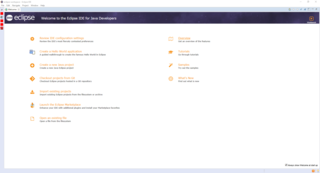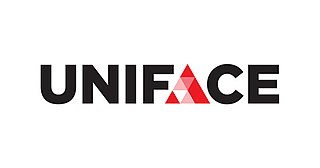Compuware OptimalJ was a model-driven development environment for Java.

Compuware Corporation is an American software company with products aimed at the information technology (IT) departments of large businesses. The company's services also include testing, development, automation, and performance management software for programs running on mainframe computer systems. The company has its headquarters in Downtown Detroit, Michigan.
Model-driven engineering (MDE) is a software development methodology that focuses on creating and exploiting domain models, which are conceptual models of all the topics related to a specific problem. Hence, it highlights and aims at abstract representations of the knowledge and activities that govern a particular application domain, rather than the computing concepts.

An integrated development environment (IDE) is a software application that provides comprehensive facilities to computer programmers for software development. An IDE normally consists of at least a source code editor, build automation tools, and a debugger. Some IDEs, such as NetBeans and Eclipse, contain the necessary compiler, interpreter, or both; others, such as SharpDevelop and Lazarus, do not.
OptimalJ was first released in 2001 [1] and was then based on Sun Microsystems' open source NetBeans IDE. Since 2006 OptimalJ is based on the open source Eclipse IDE. [2] OptimalJ was developed out of Compuware's Amsterdam offices by many of the development team responsible for the Uniface development suite.

Sun Microsystems, Inc. was an American company that sold computers, computer components, software, and information technology services and created the Java programming language, the Solaris operating system, ZFS, the Network File System (NFS), and SPARC. Sun contributed significantly to the evolution of several key computing technologies, among them Unix, RISC processors, thin client computing, and virtualized computing. Sun was founded on February 24, 1982. At its height, the Sun headquarters were in Santa Clara, California, on the former west campus of the Agnews Developmental Center.
An open-source license is a type of license for computer software and other products that allows the source code, blueprint or design to be used, modified and/or shared under defined terms and conditions. This allows end users and commercial companies to review and modify the source code, blueprint or design for their own customization, curiosity or troubleshooting needs. Open-source licensed software is mostly available free of charge, though this does not necessarily have to be the case. Licenses which only permit non-commercial redistribution or modification of the source code for personal use only are generally not considered as open-source licenses. However, open-source licenses may have some restrictions, particularly regarding the expression of respect to the origin of software, such as a requirement to preserve the name of the authors and a copyright statement within the code, or a requirement to redistribute the licensed software only under the same license. One popular set of open-source software licenses are those approved by the Open Source Initiative (OSI) based on their Open Source Definition (OSD).

NetBeans is an integrated development environment (IDE) for Java. NetBeans allows applications to be developed from a set of modular software components called modules. NetBeans runs on Windows, macOS, Linux and Solaris. In addition to Java development, it has extensions for other languages like PHP, C, C++, HTML5, and JavaScript. Applications based on NetBeans, including the NetBeans IDE, can be extended by third party developers.
OptimalJ is available in two editions:
- The Professional Edition is focused on simplifying Java EE development, by providing the capability to model a Java EE application, and then generate the application's code from the model via implementation patterns. [3] First, a platform-independent model is made, which is then transformed via technology patterns to a platform-specific model.
- The Architecture Edition provides capabilities for metamodeling and for writing implementation and technology patterns, which can be used to extend the Professional Edition. Metamodels and patterns are bundled into software factories. [4]

The Unified Modeling Language (UML) is a general-purpose, developmental, modeling language in the field of software engineering that is intended to provide a standard way to visualize the design of a system.
A platform-independent model (PIM) in software engineering is a model of a software system or business system that is independent of the specific technological platform used to implement it.
A platform-specific model is a model of a software or business system that is linked to a specific technological platform. Platform-specific models are indispensable for the actual implementation of a system.
OptimalJ was generally regarded as a technically superior but relatively expensive development environment. Compuware found it difficult to gain market share amongst the Java development community with the Optimal suite of products.

Java is a general-purpose programming language that is class-based, object-oriented, and designed to have as few implementation dependencies as possible. It is intended to let application developers "write once, run anywhere" (WORA), meaning that compiled Java code can run on all platforms that support Java without the need for recompilation. Java applications are typically compiled to "bytecode" that can run on any Java virtual machine (JVM) regardless of the underlying computer architecture. The syntax of Java is similar to C and C++, but it has fewer low-level facilities than either of them. As of 2018, Java was one of the most popular programming languages in use according to GitHub, particularly for client-server web applications, with a reported 9 million developers.
Due to internal restructurings, Compuware decided in 2008 to discontinue OptimalJ. [5]







